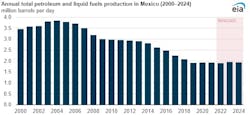EIA: Mexico's oil output stabilizes after years of decline
After nearly two decades of steady decline, Mexico's petroleum and liquid fuels production has held steady since 2019. Mexico's production is to remain relatively flat through 2024, according to the US Energy Information Administration (EIA)’s forecast.
Private companies have increased petroleum production in Mexico over the past 5 years. In 2022, Mexican government data show that private production accounted for more than 5% of Mexico's total production, a sharp increase from the 0.5% contribution by private companies in 2016.
In December 2013, after years of contentious deliberations, the Mexican government amended its constitution to open the oil and gas market to foreign and local private investors for the first time since 1938. Previously, Pemex was the only oil producer in the country.
Mexico's petroleum and liquids production peaked at 3.9 million b/d in 2004 and declined each year until production stabilized at around 1.9 million b/d in 2019, according to EIA. Based on EIA’s Short-Term Energy Outlook (STEO), Mexico's oil and liquids production is expected to remain around 1.9 million b/d through the end of 2024.
Multiple factors contribute to stable production. Declining production from the historically most productive shallow-water fields in the Sures basin (formerly known as the Campeche basin) on the southeastern coast of Mexico has been replaced by more recent field developments elsewhere in the basin, such as the 133,000 b/d from Quesqui field in 2022.
Mexico's proven oil reserves have fallen to just under 6 million bbl in 2023 from more than 10 million bbl in 2014, EIA said, citing Oil & Gas Journal. More than 80% of the reserves are in the Sureste basin, and none of the proven reserves are in deep water. While Mexico has made significant discoveries of deepsea natural gas reserves, proven oil reserves have yet to be materialized, despite extensive exploration efforts.
Woodside Energy has committed to producing Mexico's first deep water oil field in Trion field. The Mexican government plans to exploit deepsea reserves, and future development plans make further growth in private investment likely.
If Mexico's large offshore shallow-water production in the Gulf of Mexico is any indication of Mexico's deep water reserves, the Gulf of Mexico offers significant deep water production potential to the country, according to EIA.


